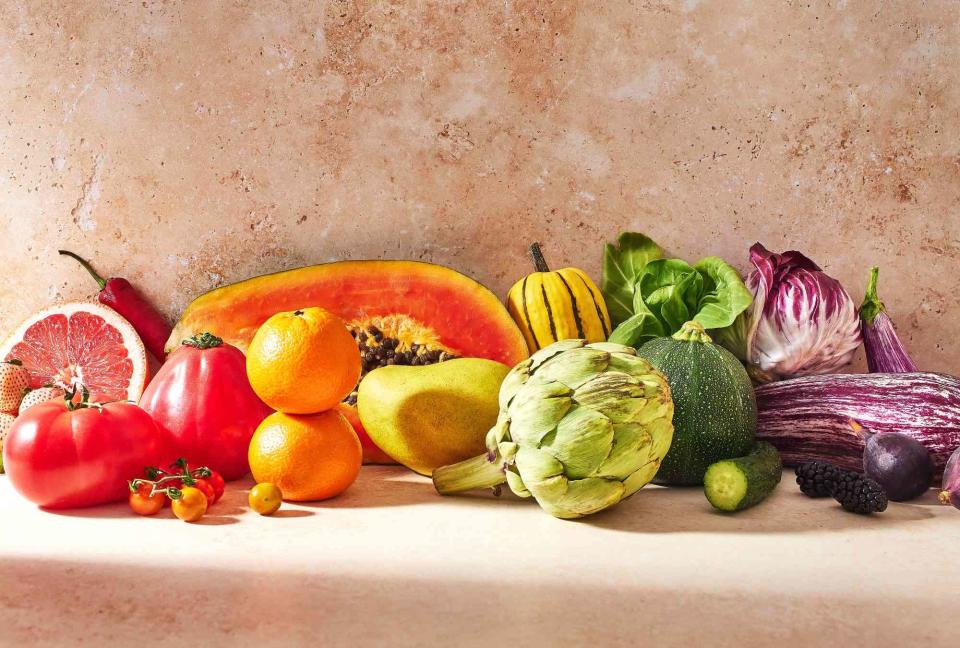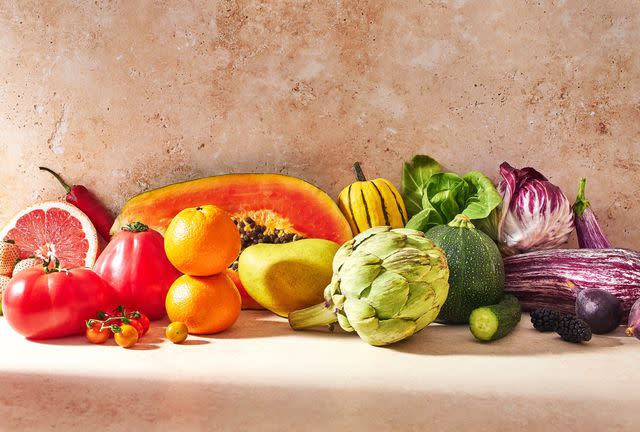The #1 Eating Habit to Gain the Biggest Benefits From the Mediterranean Diet

The benefits of tasting the rainbow!

Reviewed by Dietitian Maria Laura Haddad-Garcia
The Mediterranean diet is well-known for its health benefits, and one of the most important components of this eating pattern is consuming a wide variety of fruits and vegetables—something most of us could benefit from. According to the Centers for Disease Control and Prevention, 88% to 90% of Americans don't eat the daily recommended servings of vegetables and fruits. Eating more fruits and vegetables can help reduce your risk for chronic diseases, including high blood pressure, type 2 diabetes, heart disease, obesity and certain types of cancer. Fiber is one of the nutrients found in fruits and veggies that helps provide these benefits. According to a 2020 review in Nutrients, fiber helps improve insulin sensitivity and reduces the risk of heart disease, colorectal cancer and mortality.
Related: 7 Ways to Eat More Vegetables

Produce is also packed with antioxidants and phytochemicals. What's fascinating is that nature seems to have a way of highlighting these beneficial nutrients by giving them bright colors that allow you to spot them at a glance. For example, anthocyanins make blueberries blue and may help to keep your mind sharp. Tomatoes get their ruby hue from lycopene, a phytochemical that may help to prevent prostate cancer. To get the maximum disease-fighting power that phytochemicals can provide, choose foods representing all colors of the rainbow. This can be done via fresh, canned and frozen produce, depending on your taste preferences, budget and availability. Here's how to incorporate all of the colors of the rainbow into your diet.
Related: The 6 Best Budget-Friendly Antioxidant-Rich Foods, According to a Dietitian
1. Red Fruits and Vegetables
Red plant foods like tomatoes and watermelon contain lycopene, a phytochemical that may help protect against prostate and breast cancers. Lycopene not only has anticancer benefits but also helps reduce inflammation and the risk of diabetes, among other benefits, according to 2020 research in Antioxidants. Some delicious red fruits and veggies include:
Apricots
Blood oranges
Cranberries
Grapes
Guava
Melon
Papaya
Peaches
Pink grapefruit
Red peppers
Sweet potatoes
Tomatoes
Watermelon
2. Orange Fruits and Vegetables
Alpha and beta carotene make foods like carrots and sweet potatoes so brilliantly orange. The body converts these compounds into the active form of vitamin A, which helps keep your eyes, bones and immune system healthy. What's more, higher blood levels of beta carotene are associated with a lower risk of heart disease, stroke, cancer and overall mortality, per a 2018 study in Circulation Research. Specifically, men with the highest levels of beta carotene had a 36% lower risk of dying from any cause than those with the lowest levels. These phytochemicals also have antioxidant properties, which help neutralize free radicals that can contribute to disease. Add carotenes to your diet by eating the following foods:
Apricots
Cantaloupe
Carrots
Mango
Oranges
Papaya
Pumpkin
Sweet potatoes
Tangerines
Winter squash
3. Yellow Fruits, Vegetables and Leafy Greens
Many yellow and green vegetables are good sources of lutein and zeaxanthin, phytochemicals that accumulate in the eyes and help prevent age-related macular degeneration, a leading cause of blindness in older people, notes research in the journal Nutrients in 2022. Leafy greens are also rich in beta-carotene. To get more of these eye-healthy nutrients, eat more of these fruits and veggies:
Artichoke
Arugula
Broccoli
Brussels sprouts
Cabbage
Chard
Collards
Corn
Kale
Lettuce
Parsley
Mustard greens
Spinach
Summer squash
Turnip greens
4. Green Fruits and Vegetables
According to the National Cancer Institute, cruciferous vegetables, such as broccoli and kale, provide compounds called indoles and isothiocyanates, which may help prevent cancer. Specifically, the Institute says these plant compounds may help protect cells from DNA damage, reduce inflammation, and inhibit tumor formation. Fill up on these nutritious cruciferous vegetables:
Arugula
Bok choy
Broccoli
Broccoli rabe
Brussels sprouts
Cabbage
Cauliflower
Collard greens
Daikon radish
Green cabbage
Horseradish
Kale
Kohlrabi
Maca
Mizuna
Mustard greens
Radishes
Rutabaga
Tatsoi
Turnips
Watercress
Wasabi
5. Blue, Deep Red & Purple Fruits and Vegetables
Blue, purple and deep-red fruits and vegetables are full of anthocyanins and proanthocyanins, antioxidants that help keep your heart healthy and brain functioning optimally. In a 2021 review in the journal Pharmaceuticals, consuming anthocyanin-rich foods reduces free radicals and inflammation to counteract oxidative stress (contributing to chronic disease) and protects cells from damage. Try these antioxidant-rich foods:
Acai
Blackberries
Blackcurrant
Black carrot
Blueberries
Cranberries
Currants
Eggplant
Grapes
Hibiscus
Plums
Purple corn
Purple tomatoes
Red radishes
Red sweet potato
Raspberries
Strawberries
The Bottom Line
Of course you should eat your favorite foods, but it's important to vary your intake of fruits and vegetables and to aim to eat a rainbow of produce colors. Each color, as it's found in nature, provides a different nutrient or plant compound that has unique health benefits, including protection against certain types of cancer, type 2 diabetes and heart disease. Not only do these add different flavors, but having a rainbow of color on your plate makes each meal gorgeous, too. As they say: Taste the rainbow!

